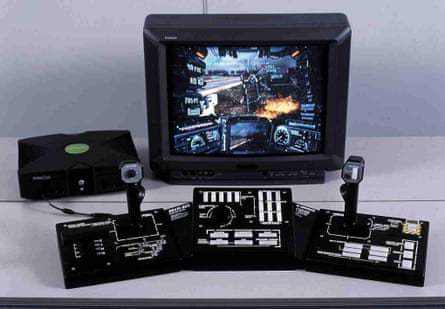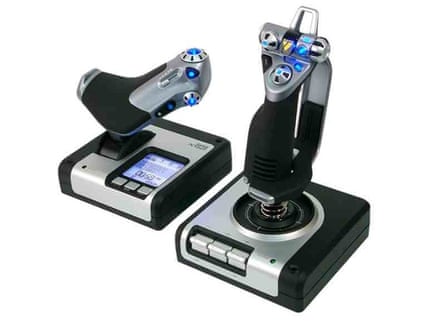I can remember my first proper joystick. It was the mid-80s and my dad had brought us a Commodore 64, “to do homework on and stuff”. He wasn’t fooling anyone, least of all himself; this sexy chunk of brown plastic was for gaming and we all knew it. Soon though, we got fed up of playing Chuckie Egg with keyboard controls, so using my birthday money, I bought a Quickshot II – the 1980s computer peripheral equivalent of a Ford Escort GTI: slightly naff, but showy and desirable.
The Quickshot II looked sort of like a real flight stick, with its gigantic red trigger buttons on the shaft, and its chunky base, complete with four sucker pads so you could stick it to the ugly MDF computer desk that you bought from Do It All. I spent countless hours playing Elite with that thing, pretending I was Han Solo, outsmarting pirate vessels throughout the galaxy. It was, to be honest, a crap joystick, really. It was brittle and insensitive, a bit like me at that age – and if you got carried away, it was easy to wrench the shaft off. And, anyway, real gamers preferred an arcade-style stick, like the Competition Pro, with its squat, sturdy build and micro-switches for precise control.
I didn’t care. The Quickshot II looked like it belonged on the control desk of the Millennium Falcon or in Maverick’s F-14 Tomcat, and for most of the 80s, those were the places I wanted to be.
Since then, I have always loved showy gaming controllers – especially the very specific ones designed to compliment simulation games. I love the plastic “dead man’s handle” contraption that comes with the Japanese train sim series Densha De Go (the special edition Shinkansen model even has its own screen). I love the PlayStation 2 RC Helicopter sim PetitCopter which comes with a joypad that looks like a remote control device. I love the 40-button control desk that accompanies the Xbox tank sim Steel Battalion.

And who can forget – or let’s face it, even remember – the fishing rod that was more or less essential for Dreamcast angling classic Sega Bass Fishing? When I edited the Dreamcast magazine DC-UK, I would storm around the office shouting “where is the bass fishing controller? Who has got the bass fishing controller?”. That is until we received a copy of the serious Latin American percussion simulator, Samba De Amigo. Then it was all, “who has taken the maracas from the games room?!”. Happy days.
Then, of course, you have the ludicrously serious driving wheels. Well, actually they’re not even just driving wheels; you can pretty much buy a car to play racing games on now. Control manufacturer Thrustmaster makes a perfect force feedback reproduction of a Ferrari F1 wheel, complete with dozens of switches and buttons – you can also get realistic foot pedals and a gear stick. And it doesn’t have to end there. Specialist companies like GT Omega will build for you an entire cockpit, complete with a bucket seat and a metal frame in which to place your realistic driving peripherals. It would take up most of your living room floor space – but it would be amazing.
For the last few years however, dedicated peripherals have fallen out of favour. The rise of the touchscreen smartphone has led to a new orthodoxy of accessibility. Everything has got to be intuitive and swipeable. The interface must become invisible, so as not to alienate people. Microsoft was so taken with this movement that it tried to convince the world that the motion controller Kinect was a really neat idea. The philosophy was clearly “hey, let’s liberate people from the need to touch anything”. But it turned out that people like to touch stuff – or at least be able to, you know, control what was happening on screen.
But now big, dedicated controllers are on the way back. There are reportedly new Guitar Hero and Rock Band games on the way (the socially acceptable face of ridiculous oversized gaming devices), and the return of space combat simulators like Elite: Dangerous and Star Citizen has meant a renewal of interest in proper sticks. When I say “renewal of interest” I know, of course, that the PC flight sim market has existed for years, creating a small but enthusiastic market for aviation controllers. It’s just that now the joystick is set to rise proudly from that arcane sector.
I have, for example, just borrowed a Saitek X52 from manufacturer Mad Catz to play Elite: Dangerous with. It is an unfeasibly complex beast, complete, not only with a stick, but also with a throttle controller. The joystick has many, many buttons. In fact, it has two mini-joysticks – or hat switches – on top, so that you can seamlessly navigate menus while navigating space. Fans of Top Gun will be thrilled that there is even a fire button that has a little spring-loaded cover over it that you can flip up. This is for your best and most dangerous missiles. I like to flick it up and hover my thumb over it, before flipping it back again, creating a sense of destructive tension and power. This is why I should not be allowed near heavy machinery.

According to Mad Catz, there are over 280 configurable control options on the Saitek X52. I have no idea what most of them do, but it is a pretty exciting thing to look at and touch. The throttle even has its own LCD display. Mine shows the time, but it can be remodelled to indicate your various personalised set-ups. To be honest, I’ve just gone for the default controls that instantly configured when Elite: Dangerous sensed that I had a Saitek X52 attached. Now I can roll, pitch and yaw with ease, while flipping the rocker buttons to activate my defence systems, or lower the landing gear. It is thrilling for the same reason the Quickshot II was thrilling all those years ago: what specialist controllers do is expand the fantasy beyond the screen; they make the game environmental and immersive. They are a form of virtual reality.
On the subject of VR, no one really knows how we’re going to move and interact in virtual worlds, so someone has to sort it out. See, for example, the Roto virtual reality chair which spins in relation to onscreen events, or Cyberith multidirectional treadmill, which will let you run through a virtual world without tripping over the coffee table and falling through your patio doors. Then there’s the quite amazing UltraHaptics device that creates tactile controls through the use of ultrasound technology – you’re effectively manipulating sound waves to control the game. To someone who was once boundlessly excited by the idea of an “auto-fire” switch, this is a magical age.
Today’s mainstream games industry is very concerned with seeming cool, attractive and accessible, so specialist controllers are something of an anachronism. Having a collection of these things is a bit like having a dressing-up box, and for a lot of adults that is kind of weird. But I’m glad joysticks are back and I will be sad to pack up the Saitek X52 and return it – although I have to because it is enormous and I can’t actually reach my keyboard anymore. When No Man’s Sky comes out, I’ll probably buy another one, and construct a little spaceship cockpit, and then hide in it. Specialist controllers add concrete, tactile reality to the fantasy of being somewhere else, somewhere extraordinary and thrilling. In 1980s Britain that was important to a boy like me. In 2015, that feeling hasn’t faded as much as it probably should have.

Comments (…)
Sign in or create your Guardian account to join the discussion